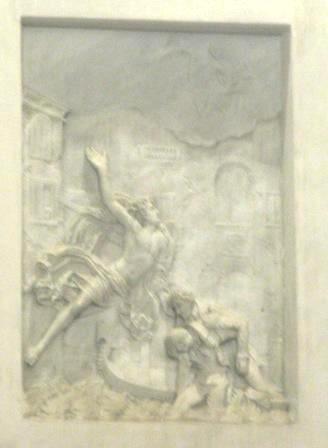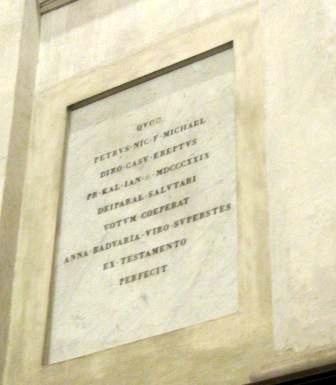One of my favorite things to do on November 21, while I’m sitting in the choir behind the high altar after finally managing to consign my candle, is to gaze upon an extraordinary bas-relief on one wall, fairly high up. It is strange and dramatic and full of emotion and I have been unable to discover any information about it except that which is implied in a memorial plaque on the facing wall.
I apologize for the quality of the photograph but was unable to improve on it in the short, crowded time I was there. Here is the carving:

I always assumed that the man survived. One reason was that the angel seems so powerful and triumphant that it’s hard to interpret in any way except that of victory or success.
The second reason (and this is only slightly cheating) was because of the dedicatory plaque facing it, which to my primitive brain seemed to be an occasion for offering thanks. Then a friend of mine who teaches Latin translated it for me. It’s not happy.
It says: “That which Pietro Nicola F. Michiel, torn from life by a mournful destiny, had begun to do [or make] on the first of January 1824 , Anna Badoer, who survived her husband, carried to completion according to the terms of his will.”
This only raises so many questions I have to remain calm. Why was he making this? I seriously doubt he was carving his own tombstone. Or perhaps he was making the stone for someone else and he died of an entirely different cause, like appendicitis or cirrhosis or gout. (Can you die from gout?) The incident itself: Who is the man and how did he end up in the water? Diabetic crisis? Suicide? Who was it that pulled him out and — who knows — attempted to administer CPR? I can’t stand not knowing the answers.
What I can tell you, by merely looking at their surnames, is that they were both from old (extremely old) patrician Venetian families. The Michiel came to the primordial Venice in the year 822, and were recorded as one of the 12 “apostolic families” of the city, as was the Badoer family, whose original surname was Partecipazio. It’s easy to find barrels of information on their families, but hardly anything about them. It’s conceivable that he was old enough to have lived during the Venetian Republic and to have gone through its fall and reincarnation as an Austrian colony, which would be enough to make me throw myself into the canal, anyway.
What little more I have been able to learn about Anna Badoer is that an oratory dedicated to her is one of four in the church of San Giorgio in a small village called Maserada sul Piave, 12 km [7 miles] northeast of Treviso. Or it was there in 1838, date of the survey document that listed the church and its possessions. This oratory would presumably not be there because she had achieved any level of sainthood, but she probably paid for it to encourage people to pray for her soul.
And, as we see, we also know that she was faithful in fulfilling her husband’s wishes, whatever or whyever they were, and that’s something worth remembering any day.

